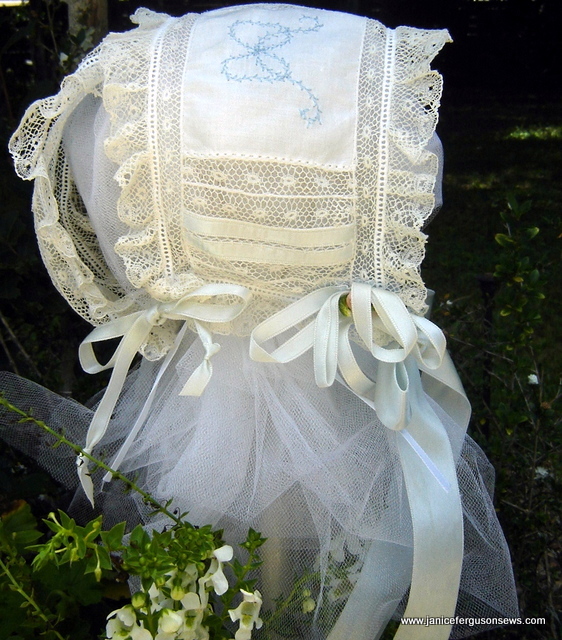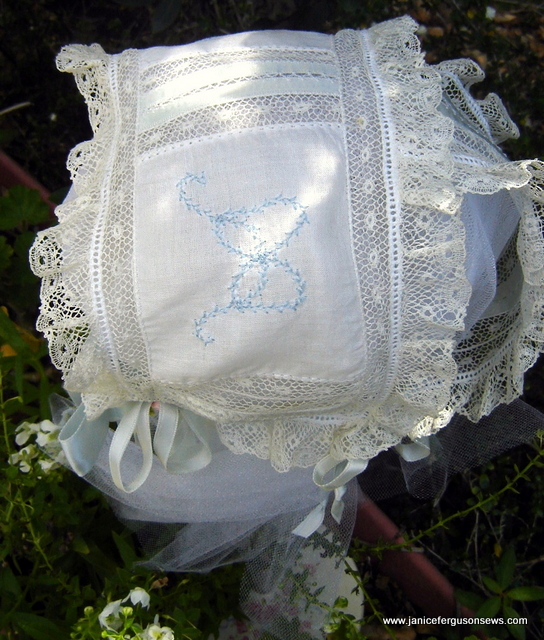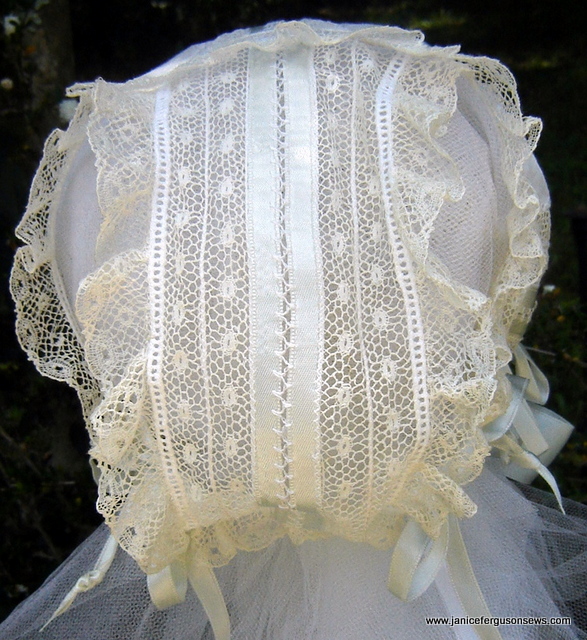There are so many projects and ideas I want to share with you, but time is just too short right now. Vivian Rose is the proud owner of a sweet little smocked popover that I will share with you later and another major project is underway. For now, this re-run~fro, 2010 will have to do.
This T-bonnet is a great little project with some interesting techniques, especially for those who do not use an embroidery machine. I hope new readers will find something of value and those of you who have already seen this post will not mind it the second time around.
~~~~~~~~~~~~~~~~~~~~~~~~~~~~
Enchanting as I find this T-bonnet to be, the techniques used in its creation hold even greater interest. At an Elna Convention outside Minneapolis, Melissa Stone, daughter of renown Sarah Howard Stone, taught this project to an eager group of students, including me.
Mind you, this was before the advent of the home embroidery machines. So for anyone who does not have an embroidery machine, this technique is gold. For those who do, the technique has applications beyond this project.
The T-bonnet is de rigueur, standard heirloom sewing. For directions and measurements for a basic t-bonnet, refer to my earlier post, unimaginatively entitled “T-Bonnet.”
In the class with Melissa Stone, we used the pattern measurements from her mother’s book, French Hand Sewing. But Melissa’s innovative idea for embroidering the bow, without the use of a water-soluble marking pen, was very creative.
After a practice session, familiarizing ourselves with the sequence of the feather stitch, the best point in time in which to pivot, the ideal tension, etc. we traced the design onto a piece of tissue paper using a #2 lead pencil. This was then pinned beneath an oversized square of Swiss batiste, sheer enough through which to see the bow design.
With the machines set at low speed, the bow was stitched over the tissue paper, taking care to pivot at the proper time. The tissue was left in place to serve as a stabilizer as the lace insertion was pin stitched to the bow square. At the end of construction, the tissue was carefully torn away. There was no need to wash out the blue lines , air dry, re-starch and repress the piece.
Another interesting technique was the machine fagoting, which joined the ribbon to the lace. The secret to success was to use double sided tape to hold the ribbon in place on another piece of tissue paper. At that time, Stitch ‘N Ditch stabilizer was either not yet on the market or unknown to Melissa or any of her students.
First, we carefully drew two lines precisely 5mm apart–the widest width capability of the Elna 9000, the top-of-the-line machine at that time. The two pieces of ribbon were secured to the tissue paper with double sided tape, with the edges of the ribbon parallel to one another and on the drawn lines. The ribbon should extend beyond the tape, so the tape does not get caught up in the stitches.
I have but one useful tip for you with regard to this project and others where you use tissue paper or Stitch ‘N Ditch stabilizer. If the stitching is delicate, such as the feather stitched bows or delicate embroidery motifs, I like to wad up the stabilizer or tissue paper into a tight, tiny ball, after which I iron it flat. This does reduce the stabilization factor, but for delicate stitching, not so much is needed. This breaking down of the stiffness makes gentle removal of the paper much less stressful on the stitching.
The T-bonnets I have shown in this post and others have all been very lacy and feminine. But this same style can be very tailored. Simply making the sections of solid fabric trimmed with tatting renders a very boy-friendly model.
To make it even more masculine, eliminate the ribbon ties that join the back to the sides and add a crocheted or buttonhole stitched loop on one corner and a button on the other. By making these modifications, you will have transformed the T-bonnet into a T-cap. Dads cannot object to that.





8 responses to “Feather Stitched Bows”